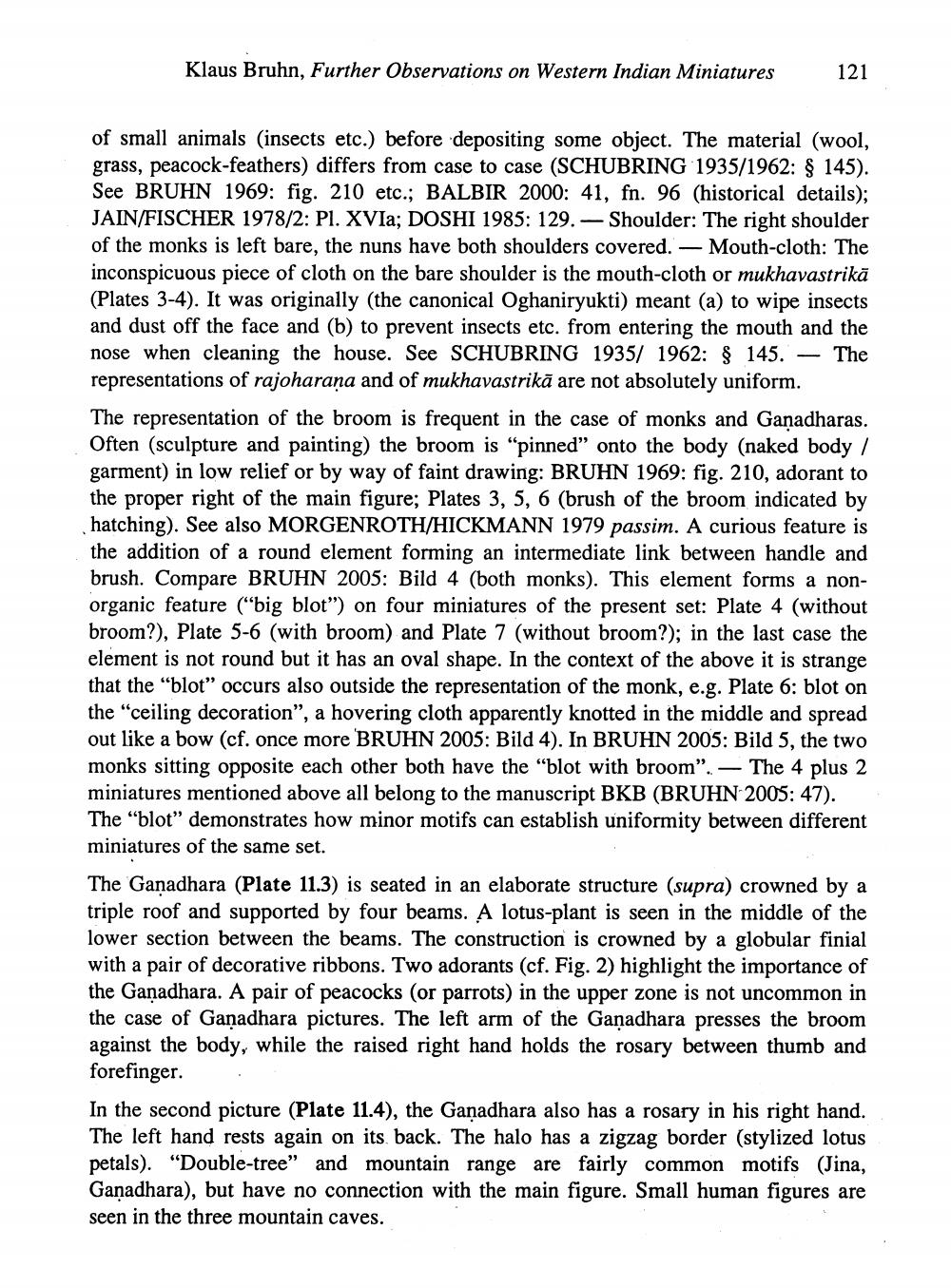________________
Klaus Bruhn, Further Observations on Western Indian Miniatures
121
of small animals (insects etc.) before depositing some object. The material (wool, grass, peacock-feathers) differs from case to case (SCHUBRING 1935/1962: § 145). See BRUHN 1969: fig. 210 etc.; BALBIR 2000: 41, fn. 96 (historical details); JAIN/FISCHER 1978/2: Pl. XVIa; DOSHI 1985: 129.-Shoulder: The right shoulder of the monks is left bare, the nuns have both shoulders covered. - Mouth-cloth: The inconspicuous piece of cloth on the bare shoulder is the mouth-cloth or mukhavastrikā (Plates 3-4). It was originally (the canonical Oghaniryukti) meant (a) to wipe insects and dust off the face and (b) to prevent insects etc. from entering the mouth and the nose when cleaning the house. See SCHUBRING 1935/ 1962: § 145. The representations of rajoharana and of mukhavastrikä are not absolutely uniform.
The representation of the broom is frequent in the case of monks and Ganadharas. Often (sculpture and painting) the broom is "pinned" onto the body (naked body / garment) in low relief or by way of faint drawing: BRUHN 1969: fig. 210, adorant to the proper right of the main figure; Plates 3, 5, 6 (brush of the broom indicated by hatching). See also MORGENROTH/HICKMANN 1979 passim. A curious feature is the addition of a round element forming an intermediate link between handle and brush. Compare BRUHN 2005: Bild 4 (both monks). This element forms a nonorganic feature ("big blot") on four miniatures of the present set: Plate 4 (without broom?), Plate 5-6 (with broom) and Plate 7 (without broom?); in the last case the element is not round but it has an oval shape. In the context of the above it is strange that the "blot" occurs also outside the representation of the monk, e.g. Plate 6: blot on the "ceiling decoration", a hovering cloth apparently knotted in the middle and spread out like a bow (cf. once more BRUHN 2005: Bild 4). In BRUHN 2005: Bild 5, the two monks sitting opposite each other both have the "blot with broom". The 4 plus 2 miniatures mentioned above all belong to the manuscript BKB (BRUHN 2005: 47). The "blot" demonstrates how minor motifs can establish uniformity between different miniatures of the same set.
The Gaṇadhara (Plate 11.3) is seated in an elaborate structure (supra) crowned by a triple roof and supported by four beams. A lotus-plant is seen in the middle of the lower section between the beams. The construction is crowned by a globular finial with a pair of decorative ribbons. Two adorants (cf. Fig. 2) highlight the importance of the Ganadhara. A pair of peacocks (or parrots) in the upper zone is not uncommon in the case of Ganadhara pictures. The left arm of the Gaṇadhara presses the broom against the body, while the raised right hand holds the rosary between thumb and forefinger.
In the second picture (Plate 11.4), the Gaṇadhara also has a rosary in his right hand. The left hand rests again on its back. The halo has a zigzag border (stylized lotus petals). "Double-tree" and mountain range are fairly common motifs (Jina, Gaṇadhara), but have no connection with the main figure. Small human figures are seen in the three mountain caves.




